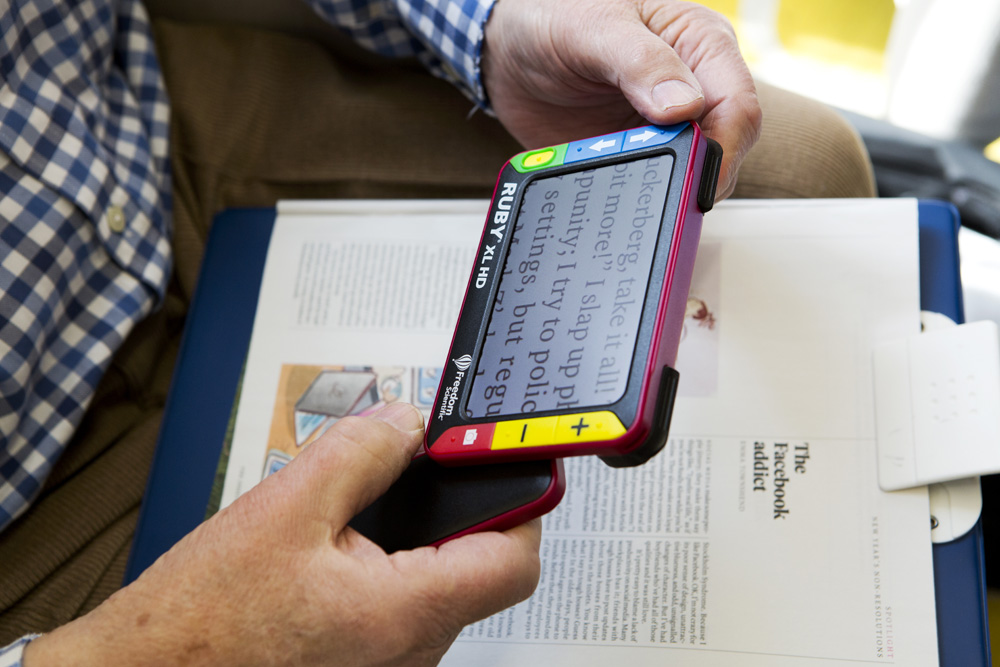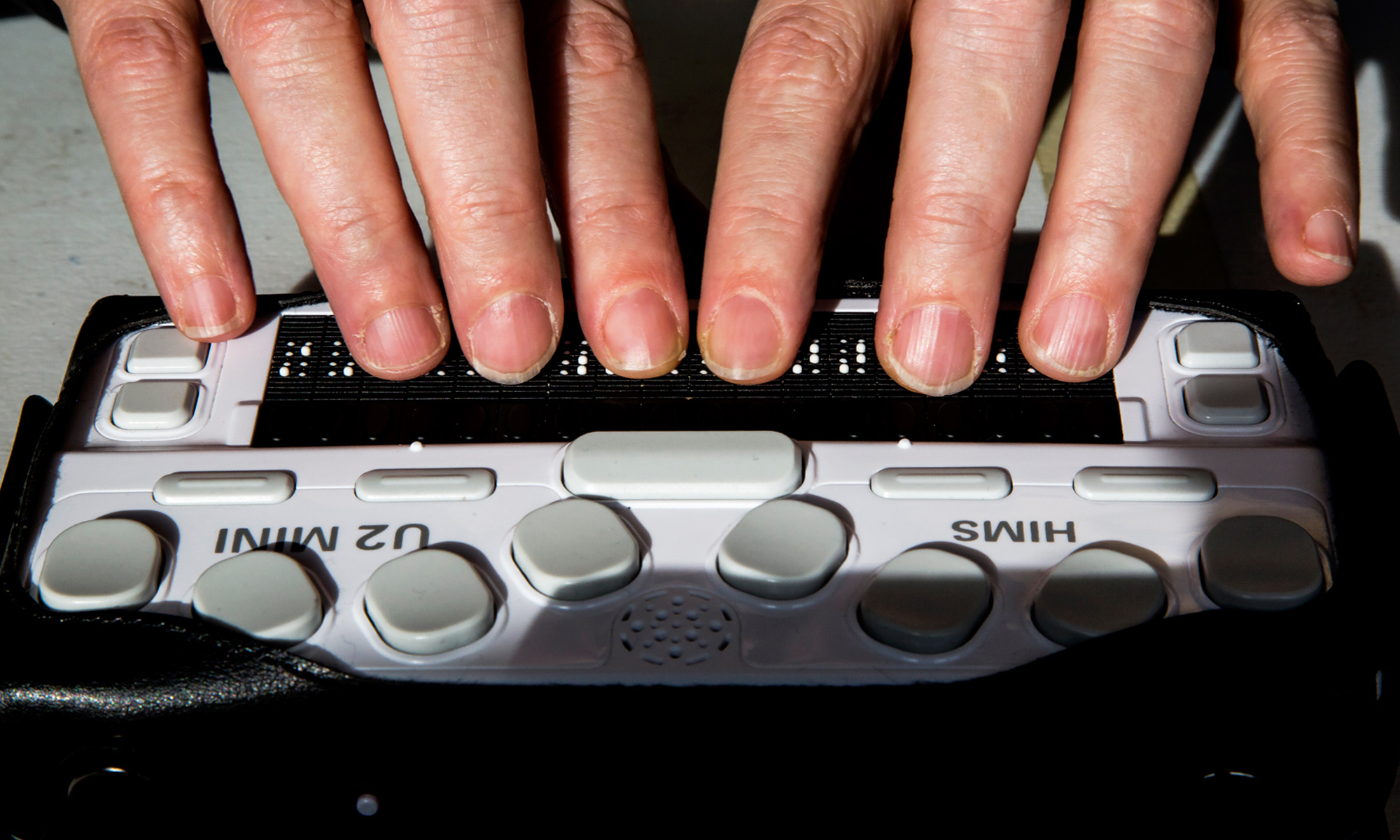Discover Innovative Devices Developed for the Visually Damaged
The growth of innovative tools for the aesthetically impaired stands for a considerable development in accessibility and independence. Technologies such as clever glasses with AI abilities and mobile applications designed to supply acoustic descriptions are reshaping everyday experiences for customers. Furthermore, wearable tools that use haptic comments improve environmental understanding, while modern-day Braille technologies use brand-new ways to involve with text. As these devices proceed to advance, their influence on the lives of those with visual disabilities increases vital concerns concerning the future of inclusivity and autonomy in different facets of life. What lies ahead in this technical landscape?
Smart Glasses for Navigation

Smart glasses developed for navigation are reinventing the method visually impaired individuals engage with their setting. These advanced gadgets utilize a combination of electronic camera innovation, artificial knowledge, and auditory responses to offer real-time info concerning surroundings. By using challenge discovery systems, wise glasses can notify customers to prospective risks, enabling more secure mobility in both strange and acquainted setups.
The assimilation of GPS technology better boosts navigation capabilities, allowing users to receive auditory directions as they move. This hands-free method not only promotes freedom but additionally equips visually impaired individuals to navigate city landscapes with boosted confidence. Additionally, many clever glasses are outfitted with features that recognize landmarks and road indicators, offering contextual information that boosts the customer experience.
Furthermore, the development of these tools is continuously advancing, with companies working to boost the precision of object recognition and broaden the variety of navigational attributes. As smart glasses end up being extra obtainable and economical, they hold the possible to considerably change every day life for visually damaged customers. Ultimately, these cutting-edge tools represent a vital action toward inclusivity, offering boosted wheelchair and a better sense of freedom for people navigating the world around them.

Mobile Application for Daily Living
How can mobile applications boost the daily lives of visually damaged people? Mobile applications are transforming the means visually damaged individuals browse their settings, take care of day-to-day tasks, and accessibility info. These applications give crucial support via different functionalities, promoting self-reliance and enhancing lifestyle.
Numerous innovative mobile applications are designed specifically for everyday living. Apps like Be My Eyes link visually impaired individuals with sighted volunteers via video telephone calls, permitting them to obtain real-time support with tasks such as reviewing tags or browsing unfamiliar areas. Likewise, Seeing AI, created by Microsoft, uses expert system to describe surroundings, read message, and determine items, properly transforming a smartphone into a powerful device for everyday help.
Additionally, navigating apps customized for the aesthetically impaired, such as Aira and BlindSquare, supply audio-based instructions and environmental details, allowing users to traverse their environments safely and confidently. Beyond navigation and immediate assistance, mobile applications also support company and task monitoring, with functions that help individuals set tips, create to-do checklists, and track visits. In recap, mobile applications function as essential sources, equipping aesthetically impaired people to lead more independent and satisfying lives.
Wearable Technologies for Assistance
Empowerment with technology is progressively evident in the world of wearable devices created to assist visually damaged individuals. These ingenious devices integrate flawlessly into day-to-day live, enhancing navigation and supplying essential comments to customers. Wise glasses furnished with cameras can recognize faces and check out message aloud, enabling individuals to connect more confidently in expert and social settings.
An additional noteworthy improvement is the use of haptic feedback systems in wearable devices. These systems use resonances or various other tactile signals to communicate information about the individual's setting, such as barriers or modifications in terrain, improving movement and security. Wearable modern technologies also include wristbands that link to mobile phones, alerting users to alerts via subtle vibrations, thus improving connection without reliance on visual cues.
As these innovations remain to evolve, they are not just improving self-reliance for aesthetically damaged individuals yet likewise promoting a better sense of inclusion in society. By linking the space in between difficulties dealt with in everyday living and the potential for autonomy, wearable technologies function as critical tools in the mission for equal rights and empowerment for those with visual impairments.
Sound Description Tools
Sound summary devices play an important duty in improving ease of access for aesthetically damaged people, providing them with the ability to engage with visual check over here media. Assistive technology for the blind. These devices use narrated descriptions of essential aesthetic elements in films, television shows, and live performances, making certain that customers can fully understand the context and feelings conveyed with visuals
Audio description can be incorporated into various systems, including streaming solutions, movie theater testings, and live cinema. Lots of popular streaming services now consist of audio description as an access attribute, permitting visitors to choose it conveniently. Along with traditional media, specialized applications also exist, offering audio summaries for art events, museums, and other cultural occasions.
The performance of audio description depends upon the ability of the narrators, who need to share visual details succinctly without diminishing the original sound. Technologies in this field are also leading the way for even more personalized experiences, where users can adjust the level of detail and pacing according to their choices.
Braille Innovations and Tools
Braille technologies and devices have actually significantly transformed the way visually damaged people engage with text and info. Modern developments have led to the advancement of versatile tools that boost proficiency and self-reliance amongst users.
Furthermore, portable Braille notetakers integrate traditional Braille input with contemporary performances, helping with note-taking, organizing, and paper editing on the go. Speech-to-text devices for low vision. These small gadgets often feature text-to-speech abilities, connecting the gap in between Braille and acoustic info
Furthermore, innovative Braille printers have actually arised, enabling users to generate Braille tags, files, and educational products effectively. This availability cultivates better involvement in specialist and educational settings, eventually promoting inclusivity.
Furthermore, study into clever Braille innovations remains to increase. Gadgets that incorporate expert system are being checked out to provide real-time navigating support and contextual information, improving the user experience in varied settings. On the whole, these advancements reflect a dedication to empowering aesthetically damaged individuals via innovation, guaranteeing they can quickly accessibility and engage with the globe around them.

Conclusion
The advancement of innovative devices for the aesthetically impaired my sources considerably boosts freedom and top quality of life. Smart glasses, mobile applications, wearable technologies, audio description tools, and Braille innovations collectively empower individuals by supplying vital navigation aid, environmental recognition, and boosted analysis experiences. These innovations not only foster greater addition however likewise promote freedom in daily activities, inevitably adding to a more fair and obtainable society for visually impaired people. Continued development in this area holds guarantee for more improvements.
As smart glasses become extra easily accessible and cost effective, they hold the prospective to substantially change day-to-day life for visually damaged individuals. Mobile apps are changing the method visually impaired individuals navigate their environments, manage daily jobs, and gain access to information. Apps like Be My Eyes link aesthetically damaged users with sighted volunteers through video telephone look at more info calls, permitting them to receive real-time assistance with jobs such as reviewing labels or browsing strange areas.In addition, navigating apps tailored for the visually impaired, such as Aira and BlindSquare, supply audio-based instructions and ecological details, making it possible for individuals to traverse their environments safely and with confidence.The improvement of innovative tools for the aesthetically impaired substantially enhances independence and top quality of life.